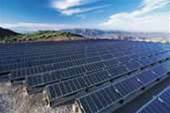
The company claims that the move will make it the world's largest manufacturer of solar power generation products.
New production lines will start rolling at the company's solar cell facility in Southern Japan later this month.
After the expansion, Sharp's total annual production capacity of pholtovoltaic solar cells will be enough to generate 600 megawatts of power, up from 100 megawatts today.
Solar panels with 600 megawatts of generation capacity would be enough to provide power for a city with a population of almost half a million.
Although Sharp does not publicly release details of its income from solar products, analysts from Nomura Securities have said that the company's "other electronic parts" business, which includes solar cells, saw strong operating profit growth of 22 percent in the first quarter of the Japanese financial year.
The same business unit went on to report a seven per cent rise in revenue in the most recent quarter, bringing its total quarterly revenue to US$1.27b.
"Photovoltaic systems are increasingly being used in Japan for industrial applications and are being installed on new residential construction in collaboration with home builders," Sharp announced.
"In Europe and the US, demand is expected to expand even further in the future, centred on industrial and commercial uses, thanks to the introduction of subsidies and implementation of policies mandating power buy-back programs by utilities."
However, following rapid expansion in global output of profitable solar cells, the industry is facing a shortage of the basic raw material, processed silicon.
Sharp claims that it is "working to make solar cells even thinner and improve thin-film solar cells which use minimal amounts of silicon, as well as establish highly efficient production systems and expand and upgrade its production lines".
Solar cells currently offer such attractive profit margins that manufacturers of other electronic components are paying tens of millions of dollars to refit production lines to make solar cells.
In spite of the wide variation in cell size and function, there are substantial similarities between many of the basic manufacturing techniques used to make silicon-based solar cells and those used to make other semiconductor products where multiple identical components are laid out in an array.
For example, cut throat pricing and intense competition in the LCD panel market have pushed some second-tier LCD makers to attempt a switch to solar panel production.
Similarly, DRam memory chip makers have also refitted plants to make photovoltaic cells.
Last month, media reports from Taiwan claimed that two local solar cell makers were seeking investment of almost half a billion dollars to expand production.



.png&h=140&w=231&c=1&s=0)






 iTnews Executive Retreat - Security Leaders Edition
iTnews Executive Retreat - Security Leaders Edition











_(1).jpg&h=140&w=231&c=1&s=0)



